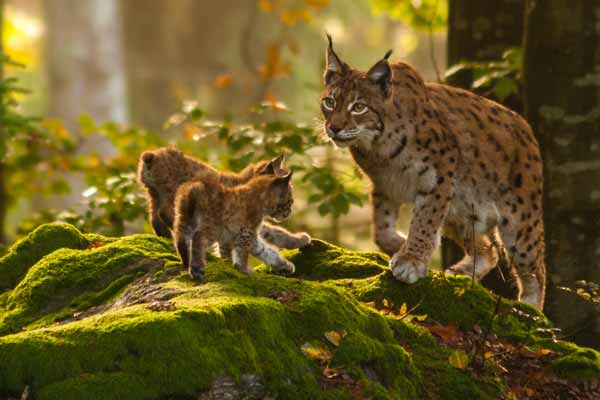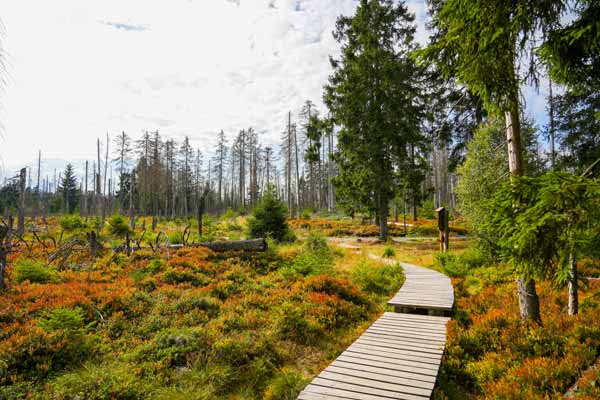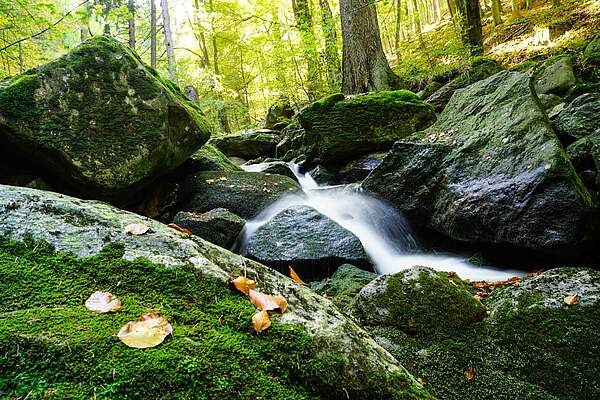
Harz National Park: Mountain wilderness shrouded in legend
The unique and legendary mountain wilderness of the transnational Harz National Park stretches over an area of around 25,000 hectares in the centre of Germany, with near-natural forests, misty moors, babbling brooks and rushing rivers as well as spectacular rock formations. Here in the Harz National Park, in the centre of which lies the Brocken at an altitude of around 1,141 metres, you will find a unique diversity of species with more than 10,000 plant, fungi and animal species. The Harz National Park covers around 10 per cent of the total area of the Harz Mountains, and 97% of the nature reserve is covered by forest - it is one of the largest forest national parks in Germany. The area of the Harz National Park covers a representative section of the low mountain range with an altitude difference of more than 900 metres from the edge zones to the summit of the Brocken. Around two thirds of the national park is located in Lower Saxony and one third in Saxony-Anhalt. On the northern edge are the towns of Bad Harzburg and Ilsenburg, while in the south the protected area stretches as far as Herzberg, with the national park extending over the high areas of the Harz down to Herzberg. The Harz National Park as we know it today was created in 2006 by merging the two national parks "Hochharz National Park" and "Harz National Park" to form Germany's first transnational national park.
Visitors to the national park are invited to explore the legendary mountain wilderness on their own on a total of around 600 kilometres of designated hiking trails. Anyone looking for information about the wild nature and the national park can contact the rangers or visit one of the national park visitor centres.
Beautiful hiking trails and interesting excursion destinations in the midst of nature make the Harz National Park a popular destination for visitors from all over Germany and beyond. Immerse yourself in the diverse mountain landscape and be enchanted by the beautiful sight of deciduous and coniferous forests, cliffs, moors and boulders!
Plants and animals in the Harz National Park
In the Harz National Park, you will find all altitude levels from hilly country to the Brockenkuppe in a very small area. In addition to the harsh climate and the different geological conditions, this is the prerequisite for the great diversity of habitats and species. Forests, moors, watercourses, rocks or the dwarf shrub heath of the forest-free Brockenkuppe - each of these habitats offers different living conditions for a rich flora and fauna. Specialists, life artists and relics of a distant ice age have also found a home here. At lower and middle altitudes, the beech is steadily reclaiming its former territory. The spruce mountain forests at higher altitudes are home to the "legendary mountain wilderness". A landscape that invites you to take a deep breath and intoxicates the senses with its wild beauty.
The wildlife of the national park: with peace and patience, there is much to discover
Hear the call of the peregrine falcon. Discover the tracks of a red deer or a lynx in the snow. Observe secret forest dwellers such as the wildcat. Encounter low mountain bird species such as the ring ouzel, pygmy owl and nutcracker. These are experiences that are possible in the Harz National Park with a little luck and patience. The various altitude levels with their different living conditions and a northern climate provide space for exceptional species. Extreme habitats such as moors, mountain streams and boulder heaps also contribute to the diversity of species.
Red deer, roe deer and wild boar are impressive wild animals. Recently, a large predator has been sneaking after them in the forests again: the lynx is back in the Harz Mountains! Its little sister, the wildcat, also has one of its last refuges here. With 18 representatives, the number of bat species is remarkable. Peregrine falcon, pygmy owl, boreal owl, nutcracker and black stork - these are just some of the ornithological treasures of the national park. The rare black woodpecker lives here in the national park as one of seven woodpecker species. Specialists such as the dipper impress with their adaptation to their extreme habitats. The ring ouzel, a bird of the Alps and the far north, nests on the Brockenkuppe and in the surrounding forest belt with a few breeding pairs. Insects, spiders and other arthropods are of fundamental importance to the ecology of the national park. Due to their large number of species, they have only been partially researched to date. To date, over 4,000 species of arthropods have been recorded in the national park, including around 1,400 species of beetles, almost 900 species of butterflies and 42 species of dragonflies, as well as over 400 different species of web spiders.

The Harz moors
Compared to the moors of the North German Plain, the Harz moors have retained their unspoilt nature and are among the best preserved in Germany. Around 2,000 hectares of the national park are boggy. Of these, 500 hectares are now particularly rare, largely forest-free raised bogs and fens. Peat cutting was not worthwhile due to the cold and damp weather in these high areas, as the peat dried too slowly.
Most of the moors are located in the western part of the Hochharz between 700 and 1,100 metres above sea level, as this is where enough rain falls. Moist, cool conditions and impermeable subsoil created wet areas after the ice age, in which peat mosses have thrived ever since. There are around 25 different species in the Harz Mountains. These rootless mosses are the basis of the moors. They grow into infinity and die at the bottom. As no complete decomposition can take place due to the high humidity, bog bodies with a thickness of up to 7 metres have gradually developed over the millennia. As a result, the vegetation of the raised bogs has lost its connection to the groundwater. Moisture and nutrients come solely from rainwater.

The Brocken: Centre of the low mountain range landscape
The Brocken is the highest mountain in northern Germany and forms the centre of the national park. As a landmark of the Harz region, its characteristic silhouette is easily recognisable from afar at a height of around 1,141 metres. Despite an average annual temperature of just 3.5 degrees Celsius and around 300 foggy days a year, you should definitely climb the Brocken summit on foot or on the Brocken railway when travelling to the Harz National Park. With a bit of luck, you can enjoy a wonderful view of the entire national park from up here. Also worth a visit is the Brocken Garden on the summit, which has been home to around 1500 plant species from various high mountain regions since 1890. The Brockenhaus also invites you to learn more about the special history and nature of the mountain. You can find more information about the Brocken here.

Nature conservation in the Harz National Park
The primary objective of national parks is to let nature be nature. National parks are landscapes in which nature is left to its own devices and its own laws. They create or preserve refuges for wild plants and animals and are therefore indispensable for biodiversity and the richness of species on our planet.
The main task of the Harz National Park is therefore to preserve and protect the natural diversity and dynamics of the habitats and the animal and plant species living there. In many areas of the national park, nature is therefore allowed to develop free from human influence.
In some areas, however, it is still necessary to support nature with forest development measures and moderate game population regulation for a certain period of time on its way to becoming self-sufficient wilderness in order to create natural retreats from cultivated land.
This landscape is not only protected as a national park. As a habitat of European importance, it is also part of the Europe-wide protected area system "Natura 2000".
The Harz National Park is an internationally recognised protected area of the highest protection class. More than 10,000 species of animals, plants and fungi find a protected home here - including many rare or endangered species.
With several million visitors a year, rules are needed to ensure that these species and their habitats are adequately protected and that you, as a guest of the national park, can continue to enjoy the legendary mountain wilderness in the future. By adhering to the national park rules, you help to preserve this unique place for everyone:
Don't leave any rubbish lying around, don't take anything from nature (especially berries and mushrooms) and always keep your dog (if you have one) on a lead. Smoking is not permitted from 15 February to 31 October. Lighting fires is prohibited all year round. Camping or bivouacking is not permitted in the national park.
Hiking in the Harz National Park
The diversity of nature along with the extensive forests makes the heart of every hiker beat faster. In the Harz National Park, there are numerous marked trails that invite you to go hiking and guarantee nature lovers unforgettable experiences. Thanks to the countless excursion destinations in the midst of nature, there are wonderful views and sights to marvel at almost everywhere along the way.
In our extensive overview of hiking trails in the Harz Mountains, you are sure to find a route to suit you.

